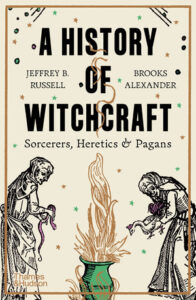A History of Witchcraft, Sorcerers, Heretics & Pagans
Jeffrey B. Russell & Brooks Alexander
Thames & Hudson, 2024, 224 p. ISBN 978-0-500-29728-5. € 17,95, $ 16,95
“In Galica, Spain, a popular phrase is Yo no creo en brujas – pero hay: ‘I don’t believe in witches – but they exist!’” The preface of the 2024 book starts with the same lines as the 1980 original that I bought in May 1986 (for ƒ 27,20). I cannot find a previous review in Wiccan Rede magazine, but I have used the Spanish phrase as a motto in online communities – fora – and also referred to the appendix of the original book several times. In it the origin of the word ‘witch’ is given. Contrary to what many people think, the Old English witan, ‘to know’, and all related words including ‘wise’ are unrelated to the origins of ‘witch’. The way the original author, Jeffrey B. Russell, explains this linguistic detail, is an example of how he presents historical facts about witchcraft. He refutes common misconceptions about sorcery and witchcraft and enlightens to a large audience that sorcery has always been around, worldwide, what it meant and how society dealt with it.
The original book already was a comprehensive account of the varied historical, anthropological and religious manifestations of witchcraft as a whole, and included chapters on modern witchcraft. The editor was right to reprint the book, and for this opportunity ‘Part II, Modern Witchcraft’ was revised by Brooks Alexander. Also added are a new preface, a new introduction, a revised conclusion and a completely updated bibliography. The author also mentions his article on ‘Witchcraft’ in the 2002 Encyclopaedia Britannica. The appendix is still included, there are still notes on the text and an (updated) index. But instead of the 94 illustrations of the old version, the new edition only counts 21 illustrations, that’s a pity.
The new chapters on modern witchcraft (or rather: Witchcraft) inform the reader of the sources of the religion that came to light in the mid 1950s. Gerald Gardner, who used material from occult sources to fill in what he experienced as a gap in the material. Doreen Valiente who subsistuted occult texts for poetry of her own hand and Celtic inspiration. Alex Sanders who with Maxine presented his own system, with again more ‘high magic’ aspects, and including gay people.
In America not only Witches from the UK (Raymond and Rosemary Buckland) brought in their own cultural heritage. Feminism plus women’s spirituality brought forth the Goddess movement, Dianic wicca, Reclaiming (Z Budapest, Starhawk). And:
Beyond its alliance with feminism, witchcraft’s emphasis on nature also resonated with the larger culture’s rising anxiety over the environment. Tim (‘Otter’) Zell was one of many witches and pagans of the period who took the notion of Earth as a living entity (James Lovelock’s ‘Gaia Hypothesis’) and conflated it with the presumed Goddess(es) of pagan religion. Zell, Starhawk, and other American witches continued to draw energy from environmental issues during the 1980’s, further increasing modern witchcraft’s social momentum and bringing it into even closer parallel with mainstream concerns.
The evolution of the internet was enthousiastically embraced by witches and pagans, as well as queer people. The website Witchvox became a very large meeting place, connecting people – worldwide – who before the internet were isolated individuals and groups.
In the 1990s, movies (The Craft) and television series led to large numbers of curious teenagers whose wishes for information and connection could not be met with the initiatiory movement. So they looked elsewhere for information, often among themselves. Witchcraft became part of teenage culture, helped by Silver Ravenwolf’s book Teen Witch but developing mostly separate from classical Wicca, and using other (social) media.
Another phenomenon was the – unexpected – warm welcome Neopaganism received in interfaith, including the 100th anniversary of the ‘Parliament of the World’s Religions’ in 1993. Don Frew:
“As we enter the 21st century, there is no question that the Craft is ‘mainstreaming’. Determining what this means will be our greatest challenge. …”
Jeffrey B. Russell in his new chapter on the role of witchcraft:
One need not be a witch to understand witchcraft as one expression of the religious experience. The ancient pagan religions, when deeply understood, are ambivalent, with both destructive and positive elements. Anthropologists, psychologists, and others have shown that they can be rich, beautiful, and insightful. Neopagan witches are attempting to retrieve the positive aspects of pagan religion and to weave them into a new, modern synthesis. The positive values inherent in this attempt include an emphasis on individual creativity and expression in moulding rites and beliefs. …
In the bookshop I saw a number of new books on historical witchcraft, but it was this concise updated volume on both historic (and anthropologic) views on witchcraft and sorcery and new ways of witchcraft that – again – caught my attention. And I still, and with renewed motives, recommend it wholeheartedly.

